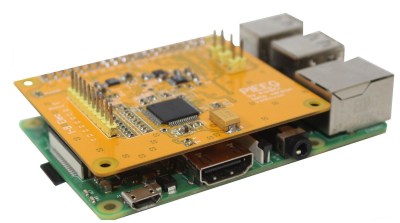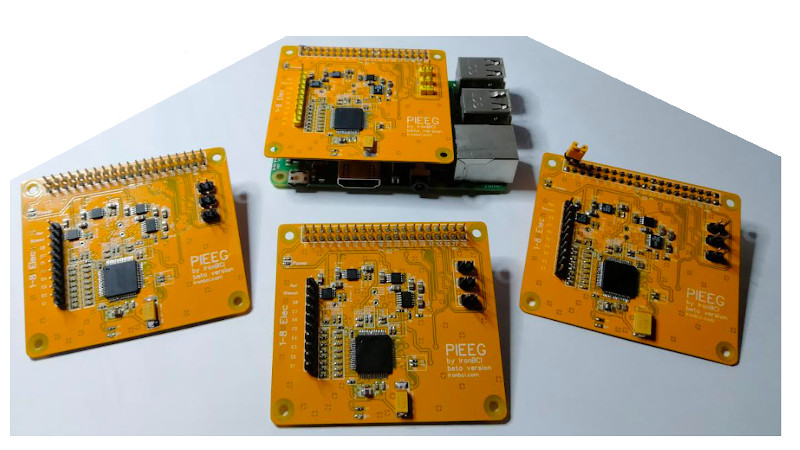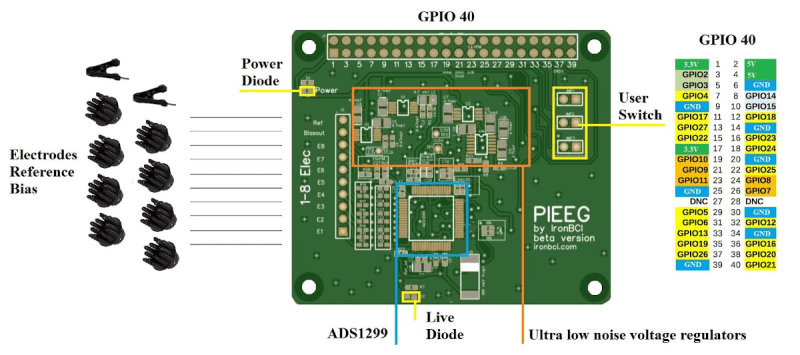One day in the future, we may interact with our electronic devices not with physical input or even voice commands, but simply by thinking about what we want to do. Such brain–computer interfaces (BCIs), combined with machine learning, could allow us to turn our ideas into reality faster and with less effort than ever before — imagine being able to produce a PCB design simply by thinking about how the completed circuit would work. Of course as an assistive technology, BCIs would be nothing less than life-changing for many.
 Today BCIs are in their infancy, but that doesn’t mean there isn’t room for hackers and makers to experiment with the concept. [Ildar Rakhmatulin] has been working on low-cost open source BCIs for years, and with the recent release of his PiEEG on Crowd Supply, thinks he’s finally found an affordable solution that will let individuals experiment with this cutting edge technology.
Today BCIs are in their infancy, but that doesn’t mean there isn’t room for hackers and makers to experiment with the concept. [Ildar Rakhmatulin] has been working on low-cost open source BCIs for years, and with the recent release of his PiEEG on Crowd Supply, thinks he’s finally found an affordable solution that will let individuals experiment with this cutting edge technology.
Implemented as a shield that can be connected to a Raspberry Pi 3 or 4, the PiEEG features 8 channels for connecting wet or dry electrodes that can measure biosignals such as those used in electroencephalography (EEG), electromyography (EMG), and electrocardiography (ECG). With the electrodes connected, reading these biosignals is as easy as running a Python script. While primarily designed for neuroscience experimentation, [Ildar] says the device is also useful for learning more about signal processing, filters, and machine learning.
At the time of this writing the Crowd Supply campaign had already hit 300% of its goal, and with a production plan in place that should put hardware in backer’s hands before the end of the year, it looks like we won’t have to wait too long before we see what the community can do with this hardware. While the hardware seems locked in, [Ildar] says work on software examples and documentation is ongoing on the project’s GitHub repository. This already includes instructions on how to make your own dry electrode EEG measurement hat, and a Python script that allows the user to operate a remotely controlled toy by blinking.
We’ve seen open hardware projects designed for biosignal measurement in the past, and we’ve even seen some commercial devices that can be used to collect this data. But the PiEEG is one of the more promising projects we’ve seen in this field, as it provides a turn-key platform for not just data acquisition but hardware interfacing. Now all you’ve got to do is find a Raspberry Pi to plug the thing into…

















On the overall subject of a brain-computer interface, while this has the potential to provide all manner of benefits, particularly for disabled people, I have no doubt that there will be some requirement to be permanently or regularly connected to whatever company provides the service, and that doesn’t sit well with me. It could be used as a way of extracting more money “not paid your bill? We’ll disable your legs!”. Or general invasions of privacy and the company controlling it all.
That is why having FOSS and FOSH developed for this type of application is a big deal. Some people use a server run by Apple et al to do text to speech, others run their own AI locally such as Larynx.
There should be a big push to liberate as much of this technology as possible and get it into the hands of indi developers, particularly at the moment when there is so many of them with free time on their hands.
That’s really cool! But I’m hesitant to call anything pi related low-cost right now thanks to the shortages.
yes, it is low-cost if compare only with another BCI
When it comes to brain-computer interfaces, affordability is not the first thing on my mind.
Somehow this does not look like there is electrical isolation. One could get away with battery power and not connecting the raspi to anything else… Urgs
Exactly what I was thinking. Brain-computer interfaces are expensive. That’s certainly due to low volume, but a big chunk of the money goes to protection of the ‘communication partner’. It seems that’s what they’re saving on in this case.
I also added this project in hackaday price
https://hackaday.io/project/190326-the-easiest-way-to-neuroscience-with-pieeg
Finally a Raspberry Pi hat that also makes sense as an actual hat.
I would love to see this thing go through a patient isolation electrical test.
Reminds me of an episode of Batman the Animated Series where the Mad Hatter places playing card sized devices in peoples’ hats or hair and gives him mind control over them. Just remove the USB and HDMI ports and there you go.
Terrible design, for many reasons:
– no galvanic decoupling between the BCI computer and the BCI electrodes.
– a looong cable between the electrodes and the digital stage. Worst case ever when one wants to measure voltages in the mV range. All that noise gathered on the way !!! Active electrodes with digital stage are the way to go
– if seems the input don´t even have a low-pass filter
– measuring at 16ksps ? what for ? signal that are in the few dozens of Hz range at max ???
Looks like a theoretical design from somebody who has no clue…
Hey Ono, this is an crazy-insightful comment here. I think your help would be invaluable for a similar design I make. If you are interested, find me as lookfwd on IG or other socials